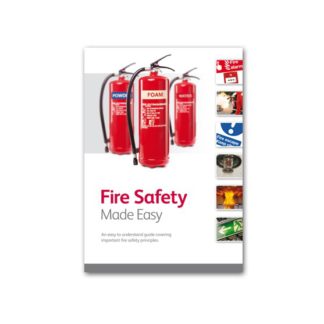Description
Fire Safety Made Easy Book
Fire Safety Made Easy has been designed to complement a range of Fire Safety and awareness courses.
- Ideal for those attending a range of Fire Safety and awareness courses
- Designed as an easy to understand reference book and learning guide
- Simple, accurate information with lots of full colour pictures and diagrams
- A logical and easy to use layout
- Includes a ‘test your knowledge’ section
The Law Regarding Fire Safety
The Regulatory Reform (Fire Safety) Order 2005 covers general fire safety in England and Wales.
In Scotland, requirements on general fire safety are covered in Part 3 of the Fire (Scotland) Act 2005, supported by the Fire Safety (Scotland) Regulations 2006.
In the majority of premises, local fire and rescue authorities are responsible for enforcing this fire safety legislation. HSE has enforcement responsibility on construction sites, for nuclear premises, and on ships under construction or undergoing repair.
Fires need three things to start – a source of ignition (heat), a source of fuel (something that burns) and oxygen:
- sources of ignition include heaters, lighting, naked flames, electrical equipment, smokers’ materials (cigarettes, matches etc), and anything else that can get very hot or cause sparks
- sources of fuel include wood, paper, plastic, rubber or foam, loose packaging materials, waste rubbish and furniture
- sources of oxygen include the air around us
What do I have to do?
Employers (and/or building owners or occupiers) must carry out a fire safety risk assessment and keep it up to date. This shares the same approach as health and safety risk assessments and can be carried out either as part of an overall risk assessment or as a separate exercise.
Based on the findings of the assessment, employers need to ensure that adequate and appropriate fire safety measures are in place to minimise the risk of injury or loss of life in the event of a fire.
To help prevent fire in the workplace, your risk assessment should identify what could cause a fire to start, ie sources of ignition (heat or sparks) and substances that burn, and the people who may be at risk.
Once you have identified the risks, you can take appropriate action to control them. Consider whether you can avoid them altogether or, if this is not possible, how you can reduce the risks and manage them. Also consider how you will protect people if there is a fire.
- Carry out a fire safety risk assessment
- Keep sources of ignition and flammable substances apart
- Avoid accidental fires, eg make sure heaters cannot be knocked over
- Ensure good housekeeping at all times, eg avoid build-up of rubbish that could burn
- Consider how to detect fires and how to warn people quickly if they start, eg installing smoke alarms and fire alarms or bells
- Have the correct fire-fighting equipment for putting a fire out quickly
- Keep fire exits and escape routes clearly marked and unobstructed at all times
- Ensure your workers receive appropriate training on procedures they need to follow, including fire drills
- Review and update your risk assessment regularly
Do you have a question about this product? – “Ask Wessex”











Reviews
There are no reviews yet.